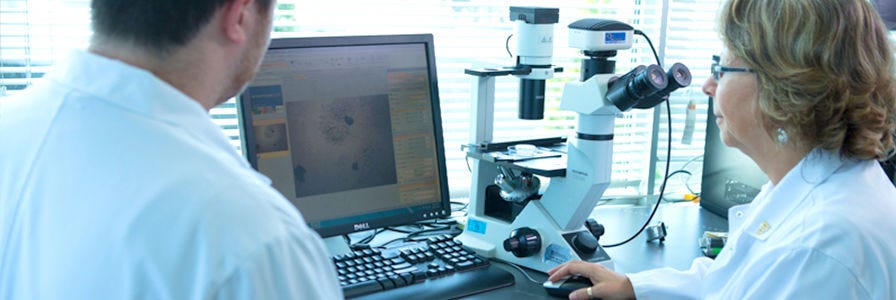Biopharmaceutical and Biosimilar Assessment
With Contract Assay Services
Biopharmaceutical drugs, also known as biologics, have become an essential part of modern pharmacotherapy and include examples such as biological proteins, cytokines, hormones, monoclonal antibodies, vaccines, and cell- and tissue-based therapies. Biopharmaceuticals may include compounds such as biosimilars, molecules meant to be an improved version of a previously developed drug on which the patent has expired.
The hematopoietic colony-forming cell (CFC) or colony-forming unit (CFU) assay can be used to test the activity of biopharmaceutical cytokines. Hematopoietic progenitors are isolated from human bone marrow, and plated in a CFU assay to observe the direct stimulatory effects of test articles on progenitor growth and morphology. The effects of these cytokines can be similarly evaluated in animal models. For example, the data below show the effects of erythropoietin (EPO) measured in vitro (Figure 1, Table 1) and in vivo (Figure 2, Table 2), and of granulocyte-stimulating factor (G-CSF) (Figure 3). Hematopoietic progenitors are isolated from human bone marrow, and plated in a CFU assay to observe the direct stimulatory effects of test articles on progenitor growth and morphology. The effects of these cytokines can also be evaluated in animal models.
Contact us to learn more about how you can employ the CFU assay in your organization.
Example Data from Previous Studies

Figure 1. The Effect of EPO on Erythroid Colony Growth in CFU Assays of Human Bone Marrow Cells
Human bone marrow mononuclear cells were isolated from three individual patients and plated in CFU assays using MethoCult™ medium, in the presence of decreasing concentrations of control erythropoietin (EPO). The percentage of erythroid colonies in samples treated with decreasing concentrations of EPO-based biosimilars can be compared to the number of colonies supported by an optimal concentration of Control EPO as determined by this graph and Table 1 below.
Table 1. EC50 Values for the Effect of EPO on Erythroid Colony Growth in CFU Assays of Human Bone Marrow Cells


Figure 2. Mobilization of Erythroid Progenitors and Increased Erythropoiesis in Mice Treated with EPO
Wild type BDF1 mice were treated with EPO on days 0 and 1. On day 4 the mice were sacrificed and the progenitor content of the spleens was assessed by plating cells in a CFU assay and counting the number of erythroid (BFU-E) progenitors per spleen. The percentage of reticulocytes were also measured by flow cytometry (Table 2).
Table 2. The Number of BFU-E Measured by a CFU Assay and Percentage of Reticulocytes as Measured by Flow Cytometry per Spleen Isolated from Mice Treated with EPO


Figure 3. The Total Number of CFU Observed in the PB of Mice Following Treatment With G-CSF
C3H/HeN mice were treated with 5 µg rhG-CSF per day on days 0 - 2. Eighteen hours after the last G-CSF injection mice were sacrificed and the peripheral blood (PB) was collected. The progenitor content of in the PB of each mouse was then assessed in a CFU assay. Mice treated with G-CSF showed a 10-fold increase in the number of CFUs per mL of PB when compared to vehicle control.


